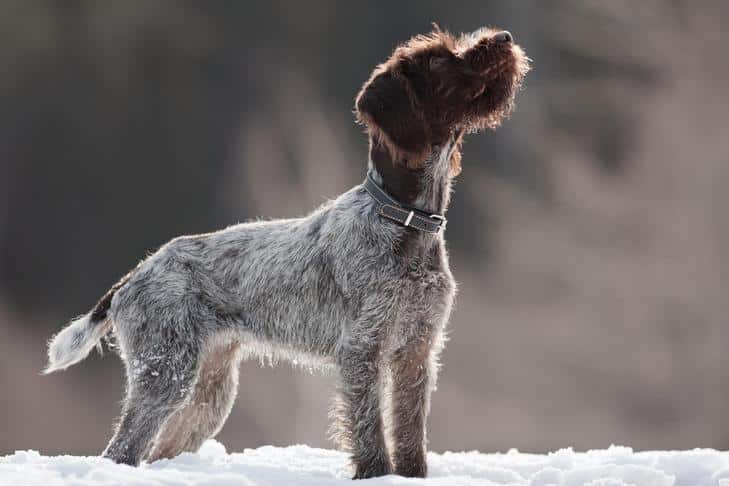Your home could contain many potential household hazards for dogs. It’s essential to make sure that dog’s environment is safe, but hazards aren’t limited to inside the home. When you’re outside with your dog, don’t forget about a life-threatening hazard in driveways and garages: antifreeze. If they’re given the chance, dogs will lick up antifreeze, and even a tiny amount can be fatal to dogs. It’s important to know the symptoms of antifreeze poisoning in dogs and what to do if you suspect your dog has ingested some.
Why Is Antifreeze, and Why Is It Dangerous for Dogs?
Antifreeze is a chemical used to help regulate a vehicle’s engine during extreme temperatures. The brightly colored liquid can drip from under your car or spill from a container when you’re filling your coolant reservoir, creating puddles. If they come across antifreeze puddles in garages, parking lots, or driveways, your dog may want to investigate.
According to American Kennel Club Chief Veterinarian Dr. Jerry Klein, ethylene glycol (the major ingredient in most types of antifreeze) is very dangerous for dogs. This odorless chemical isn’t just in antifreeze, though. Ethylene glycol also appears in some windshield de-icers, hydraulic brake fluids, paints and solvents, and even ballpoint pens and cosmetics, although in lower, less dangerous amounts.
Even if your dog eats only a small amount of antifreeze, severe poisoning can result. And unfortunately, dogs may purposely drink antifreeze, likely because ethylene glycol has a sweet taste. Even walking through antifreeze is a risk if your dog licks their paws afterwards.

Can antifreeze kill a dog? Unfortunately, yes. “Ingesting as little as half a teaspoon per pound of a dog’s body weight can result in fatality,” Dr. Klein says. What does antifreeze do to a dog? Initially, the ethylene glycol acts on the central nervous system. Then the liver begins to metabolize the chemical into hazardous byproducts that damage the kidneys and shut down urine production.
Dr. Klein warns that dogs must be treated within eight to 12 hours after consuming antifreeze, or else the antidote will be ineffective. “Once an animal begins to show clinical signs of poisoning, such as staggering and weakness, it’s often too late,” he explains. “Left untreated, ingestion of ethylene glycol is fatal.”
What Are the Symptoms of Antifreeze Poisoning in Dogs?
The symptoms of antifreeze poisoning in dogs vary, depending on the amount ingested and how long has passed since your dog was exposed. This breaks the poisoning into three stages.
Stage 1 of Antifreeze Poisoning in Dogs
The first stage occurs within 30 minutes to 12 hours after ingestion. Your dog might show the following signs, which are similar to symptoms of intoxication:
- Lethargy in dogs
- Dog depression
- Lack of coordination and staggering
- Dog vomiting, sometimes accompanied by doggie diarrhea
- Increased thirst and drinking
- Increased urination
- Hypothermia (low body temperature)
Some dogs will experience seizures or even enter comas during this stage.
Stage 2 of Antifreeze Poisoning in Dogs
During the second stage (taking place 12 to 24 after your dog ate antifreeze), your dog might seem to improve. But Dr. Klein warns that any improvement is usually temporary. Although the external symptoms of antifreeze poisoning may decrease, the internal symptoms (including doggie dehydration, increased heart rate, and increase in breathing rate) will be getting worse.
Stage 3 of Antifreeze Poisoning in Dogs
By the third stage (36 to 72 hours after consuming antifreeze), your dog’s kidneys will show signs of severe deterioration. Having swollen kidneys prevents your dog from producing urine. When they try to go to the bathroom, very little pee (or nothing at all) will come out. Is antifreeze poisoning painful to dogs? It is — especially at this stage, thanks to their swollen kidneys.
You might see earlier symptoms (like lack of appetite in your dog, lethargy, depression, and vomiting) reappear. And in their final hours, your dog might suffer seizures or a coma. And sadly, many dogs who progress to the third stage of antifreeze poisoning will die.
How Is Antifreeze Poisoning in Dogs Diagnosed?

How do vets test for antifreeze poisoning in dogs? Dr. Klein says the best way to confirm your dog has ingested antifreeze is to measure the concentration of the chemical in your dog’s blood. “This test to determine the blood levels can be done at some veterinary diagnostic laboratories or human hospitals and is very accurate, but many local animal hospitals may not have it,” he says.
Some emergency animal hospitals and vet clinics use test strips to detect ethylene glycol in the blood. However, these test strips aren’t always accurate, and false positives can occur. Plus, if too much time has passed, they can deliver a false negative. Dr. Klein explains that the highest levels of ethylene glycol in your dog’s system occur in the first one to six hours after ingestion, and to get accurate results, a vet must use these test kits during that period.
Once kidney failure has occurred, urinalysis and blood tests can confirm the damage, although they won’t specifically show the cause. But by the time these tests point to suspected antifreeze poisoning, it will probably be too late for the antidote to be effective.
Finally, Dr. Klein says your vet might use a black-light lamp to examine your dog. Antifreeze has a warning dye added to it. If your dog has been exposed to antifreeze, this lamp can spot the dye on your dog’s paws and muzzle or in their urine.
How Is Antifreeze Poisoning in Dogs Treated?
According to Dr. Klein, if your vet suspects antifreeze poisoning, they will start treatment with an antifreeze antidote while waiting for confirmation from diagnostic tests. “Antidotes are a drug called fomepizole or ethanol. Intensive intravenous fluids are administered along with the antidotes, as well as other medications to combat nausea and vomiting, as well as supportive care.” He adds that your vet will monitor your dog’s electrolyte levels, blood pH, and how much urine they produce.
Although you might want to make your dog vomit up antifreeze, don’t do this without first contacting a veterinarian or poison control hotline. Because your dog’s system absorbs antifreeze so fast, inducing vomiting might make no difference. More importantly, vomit can create a choking hazard if your dog is showing neurological signs like staggering or lack of coordination. “When in doubt, if you even suspect your dog has ingested antifreeze, seek immediate veterinary attention,” Dr. Klein says. “Once clinical signs have developed, the prognosis is very poor.”
How Can You Keep Your Dog Safe From Antifreeze Poisoning?

Thankfully, dog-safe antifreeze exists. According to Dr. Klein, they contain propylene glycol as an ethylene glycol alternative, and dog-safe antifreeze don’t pose the same danger to dogs. If possible, it’s best to use these for your vehicle instead, but it’s still important to keep your dog away from inhaling or ingesting any chemicals.
Keep your antifreeze in sealed, leak-proof containers where your dog can’t access them. Check your garage and driveway regularly for any liquids that have leaked from your vehicle. If you’re not sure how to dispose of your used antifreeze, contact the nearest Household Hazardous Waste (HHW) program.
You may use also antifreeze in your toilets to prevent the pipes from freezing, or take your dog somewhere that does. If that’s the case, make sure the toilet lid is down and the bathroom door is closed when your dog is nearby.
Finally, keep the contact information for ASPCA Animal Poison Control and Pet Poison Helpline easily accessible. They provide 24-hour, seven-day-a-week expert advice for any animal poison-related emergency. A consultation or incident fee may apply, but it could make a life-or-death difference for your dog.







